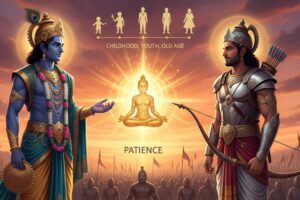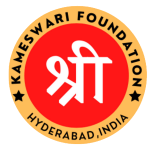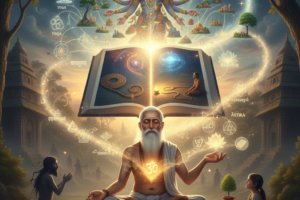
Ch-1|Meaning of Shlokas 26-30
- Posted by Sri Kameswari Foundation
- Date June 9, 2025
- Comments 0 comment
In the previous episode,upon Arjuna’s request,Bhagavān Śrī Kṛṣṇa drove the chariot to a position between the two armies—precisely where Arjuna could clearly see revered warriors such as Bhīṣma and Droṇa.There,He asked Arjuna to observe the Kaurava forces.
When Arjuna asked Śrī Kṛṣṇa to place the chariot in the middle of the battlefield,he might have intended merely to get a clearer view of the opposing army.However, Bhagavān Śrī Kṛṣṇa,the omniscient One,positioned the chariot in a manner that would awaken a deep emotional and psychological response in Arjuna—an inner turmoil that ultimately became the very cause for this profound scripture to manifest amidst the battlefield.
Similarly,in our own lives,when we surrender to the Divine and pray for a particular outcome,He knows what to grant,how to grant it,and when.Though His response may not always seem pleasant or understandable at first,it often turns out to be a far greater blessing in the long run.
The essential quality a devotee must cultivate is complete surrender,just as Arjuna surrendered to Śrī Kṛṣṇa—free of doubt and full of trust.This spirit of surrender is the master key to liberation (mokṣa).
The ślokas discussed in this episode are pivotal in understanding why this chapter is titled “Arjuna Viṣāda Yoga”.
Śloka 26: After listening to Śrī Kṛṣṇa’s words, Arjuna beheld those assembled on the battlefield: elders such as Bhūriśravā (son of Somadatta), grandfathers like Bhīṣma, preceptors like Droṇa, uncles such as Śalya (the brother of Mādrī), brothers like Duryodhana, and sons of the Kauravas including Lakṣmaṇa. He also saw their sons—Arjuna’s grandsons—as well as those who had given their daughters in marriage to his family, friends like Kṛtavarmā, and other close companions—all standing prepared for battle.
Śloka 27: Seeing all his relatives on the battlefield, Arjuna—standing amidst the war field—was overwhelmed with deep compassion and sorrow, and began to speak to Bhagavān Śrī Kṛṣṇa in this manner.
Śloka 29: In this verse, Arjuna refers even to those who denied the Pāṇḍavas their rightful kingdom, and who now stand ready to kill them, as his own people. Overcome by misplaced compassion, his body begins to tremble, his limbs grow weak, his mouth dries up, and he experiences horripilation (goosebumps)—a physiological reaction to the emotional turmoil he is undergoing.
Śloka 30: Arjuna begins to lose grip over his Gāṇḍīva bow, symbolic of his warrior spirit. He is gripped by self-doubt and anxiety, as he contemplates the consequences of engaging in battle against his own kin. His skin feels as if it is burning, and he confesses to Śrī Kṛṣṇa that he can no longer remain in the battlefield, for his mind has become unsteady and disturbed.
You can also listen to this in Telugu from our Āchārya,Dr. Jammalamadaka Suryanārāyaṇa garu,by clicking the video below.
You may also like

Ch-2|Meaning of Shlokas 13-14


